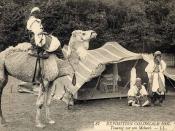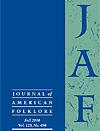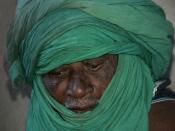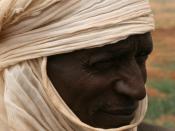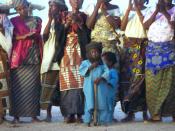Grief at seeing a daughter leave home: weeping and emotion in the Tuareg techawait postmarital residence ritual.
Author: Rasmussen, Susan. Source: Journal of American Folklore v. 113 no450 (Fall 2000) p. 391-421 ISSN: 0021-8715 Number: BHUM01012016 Copyright: The magazine publisher is the copyright holder of this article and it is reproduced with permission. Further reproduction of this article in violation of the copyright is prohibited.
Among the Kel Ewey Tuareg of the rural Air Mountains in Niger, West Africa, a ritual called techawait (a term also denoting "poetry") is held when a married couple moves away from the wife's parents, where they have previously resided in initially uxorilocal residence, after approximately the first two or three years following their wedding. This rite is enacted expressly, Tuareg inheritance runs through both matriline and patriline; earlier matrilineal influences persist today in alternative forms of inheritance, ritual and symbolic references to matriliny, and close brother-sister ties, although patrilineal institutions first introduced by Islam have become more prevalent in many groups.(FN6)
Members of each Tuareg descent group, the tawsit, define themselves as uterine descendants of a single eponymous ancestress. Women control their property, including livestock herds inherited in special "living milk" (akh ihuderan) property reserved for sisters and daughters and intended to counterbalance Koranic inheritance. Women own the family tent, may reject suitors, and may divorce their husbands. Premarital courtship is allowed at festivals called tende and ahal outside the village or camp. Women do not share in official political leadership of the descent group or confederation, however.
The tent is the basic unit of Tuareg society; in rural nomadic and seminomadic communities, a tent defines a family. The tent is not only a woman's domestic space, it is also a woman's property. Besides her jewelry, which she receives from her mother and her husband upon marriage--delivered to her by smiths/artisans attached to her own and her husband's families--and which she may retain upon divorce, the most important objects owned by a woman are her marriage bed and her tent, which is constructed from a portion of her mother's tent cut out at the time of her marriage and reconstructed by the smiths/artisans or former slaves in some groups and by elderly female relatives in other groups. The new husband joins his wife in her tent, and this will be their home as long as the marriage lasts. Even upon moving to virilocal residence, as noted, the woman's nuptial tent is transplanted rather than abandoned. Its interior is divided into halves by gender, the men's to the east and the women's to the west. Although the men's objects, such as saddles and arms, are stored in their half, the men themselves normally spend almost all of their time outside the tent, sleeping outside it from puberty onward. In the women's half are kept the stores, musical instruments, and the marriage bed, which serves during the day as a sofa for the wife and her children. Although boys and girls are raised together, the boys' exit from this tent at puberty means that the girls spend more time with their mothers and thus learn much more of the abundant folklore. Transmission of verbal art is traditionally in the hands of women, inside the tent. The local Tamacheq alphabet, Tifinagh, for example, is traditionally taught by a mother to all her children, although the more devout Muslim Tuareg tend to oppose Tifinagh to Islam and the language of the Koran, Arabic.
Tuareg women continue to enjoy relatively high social prestige and economic independence, and there is free social interaction between men and women in formalized courtship and conversation, in women's right to inherit property, and in their abilities to visit without husbands' permission and to initiate divorce Upon divorce, the woman keeps her tent if she has children. If, on the other hand, she has been married only briefly and lacks children, she often returns to her family and her tent is gradually destroyed.
In the cultural elaboration of marriage, personal preference and love sentiment are not entirely disregarded. In Tuareg culture, individual romantic choice is glorified in a large body of poetry and song. Freedom of social interaction between the sexes and a highly stylized courtship institution challenge the constraints of marabouts' disapproval of premarital and extramarital affairs, official marriage "rules," and elders' efforts to contract economically advantageous matches that will ensure solidarity and continuity of the tent over the long term. There is often conflict over the two principle forms of marriage: the arranged marriage, called "a family marriage," and the love marriage, called "a man's marriage." Most first marriages are arranged by parents. Mothers prefer close cousin marriages--often matrilateral parallel cousins, in order to keep property within the family and minimize conflict between affines . Women are not supposed to reveal love preference; they may only veto an undesirable suitor. Many women can only express love preference through music, poetry, and song. Many songs at festivals and spirit possession rituals express sadness over thwarted or hidden love, loss of love through travel, or conflict with parents over love choice. Fem Sorrow over loss--specifically in the domain of love and marriage, kinship, residence, and travel--is a pervasive theme in Tuareg culture. This theme is obliquely expressed through symbol and metaphor in music. A popular verse in songs sung at predominantly female spirit possession rituals, for the purpose of "pleasing" the spirits, alludes to an orphan, stating, "Oh, my soul! I am an orphan," and further to "a mother camel without her child," "a mother camel who has lost her child," and "little camels crying in the shadows of trees" (Rasmussen 1995). The camel here is a metaphor that is, importantly, ambiguous and open to diverse interpretations: it may signify a lover or a maternal bond.
Marriage, family, and the faith: women's conversion to Islam.
Author: Shatzmiller, Maya. Source: Journal of Family History v. 21 (July 1996) p. 235-66 ISSN: 0363-1990 Number: BSSI96027996 Copyright: The magazine publisher is the copyright holder of this article and it is reproduced with permission. Further reproduction of this article in violation of the copyright is prohibited.
. The increase in the size of the Muslim community during the first three centuries of its existence came about mainly through conversion rather than and less through internal growth. But could we declare categorically that women followed their husbands in conversion? Could we declare that for every converted man, there was a converted woman, or a woman and children who joined the Muslim women did not convert as readily as men. This enigma, as well as related questions, will be better understood through the study of Andalusian notarial conversion documents for women, which the broader question of how women's conversion fitted in with the development of the Maliki school of family law in al-Andalus, and how it was incorporated into the general framework of the status of women and the family in Islamic law and society.
The conversion certificates for women appear in the collection of Maliki school notarial documents from tenth century Cordoba, compiled When a pagan woman converts, the marriage is not invalidated immediately, but the pagan husband, if he wants to retain his marriage, is given a delay of two to four months, while his wife is in the cidda, the waiting period, and he "is invited" to convert.(FN25) On the other hand, if the husband converts before his pagan wife, and she is offered the opportunity to convert and refuses, they must separate immediately.( whether a marriage remained valid or should be annulled following conversion.
, mother-milk (p.31) and . When a kitabiyya, or pagan married woman, converted to Islam without her kitabi, or pagan husband, she set in motion a process that could end either in validation or annulment, depending on whether the husband chose to convert.
, because the law was that a Muslim woman could not be married to a non-Muslim man.(FN44) However, if her husband converted at the same time, annulment would not occur. In that case, regardless of whether he is a kitabi or pagan, his immediate conversion would produce two Muslims married to one another. This marriage might be invalidated later on other grounds, but for the time being, it was valid: "In case he converted with her she is his wife, their marriage is not demolished," says Ibn al-cAttar.(FN45).
A second option to save the marriage could be exercised during the wife's waiting period. In conformity with the Islamic law of divorce, the new Muslim wife, whose husband did not convert with her, had to wait for three months before being free to remarry, because the marriage had been consummated and the possibility of a pregnancy must be anticipated: "When a married woman converts (without her husband), her marriage is invalidated and she is told to enter the waiting period.... If he converts during her cidda and before she has three menses from the time of her conversion, if she is from those who menstruate, and three months if she is someone who does not menstruate, he will remain with her in a state of marriage."( and if he converted after that, he is available for marriage to others." This is clear because the end of the waiting period signaled in law that the divorce was definitive and that both the woman and the man were available to marry other people. Could be a divorce mechanism for a woman! Shows that women have autonomy regarding their faith"æat least, in this direction.
The fate of a marriage of two pagans was examined according to the same principles. Upon the conversion of either the husband or the wife to Islam, it would immediately be dissolved, because no Muslim, man or woman, can legally be married to a pagan.( A pagan husband could still save his marriage by a delayed conversion while his converted wife was in the waiting period. A delayed conversion of the pagan wife, however, did not count. She would no longer be considered his wife, and a separation between them automatically ensued The marriage pillars, arkan, are five: the husband, the wife, the legal guardian, the dowry, and the wording formula, sigha. In the first pillar, that which regards the couple, there are seven characteristics, awsaf, which must be present, the first being Islam. We can envisage 4 prospects here: (1) a marriage of a Muslim man with a Muslim woman, (2) a marriage of a nonbeliever, kafir, with a female nonbeliever--these two are legitimate, (3) a marriage of a nonbeliever with a Muslim woman is not permitted and all jurists agree that it should be terminated by divorce, (4) a marriage of a Muslim man with a nonbeliever is allowed if the woman is from the people of the book, kitabiyya, marriage with any other nonbeliever female is not allowed. Malik (Ibn Anas, founder of the Maliki school in eighth century Medina) also condemned marriage with a woman from the people of the dar al-harb (people with whom the Muslims are engaged in war) because the child will remain in the abode of war.(FN49).
The marriage of two slaves, Christian or Jewish, to one another is permitted. If the slave converts slave children, children born to a marriage within the forbidden degree, and children in the custody of a divorced mother. These bore the consequences of their parents' conversion to a large or lesser degree. The initial dictum was that a child followed his father in religion and his mother in civil status, either freedom or slavery, 'l-huriyya wa 'l-riqq.(FN64) That did not mean that all children of a converted father automatically became Muslims. Only a child younger than seven years, whether male or female, would become Muslim, dakhala Islam abihi.(FN65) A child older than seven years retained his birth religion. The age of seven was selected here under the assumption that this was an age at which a child was capable of making a reasoned decision about religion, children born of a marriage with a woman of the forbidden degree. After the dissolution of the marriage, a child became a Muslim if still minor. This child is attached to the father (namely, fully legitimate) and unlike children born from an adulterous relationship, could inherit from him. This was because, as the jurist explained, adultery, zina', in Christianity was not (as bad) as adultery in Islam.(FN69) If a pregnant wife was of the forbidden degree, however, the law was not so kind. She was forced to separate from her husband at the time of his conversion but being entitled to the rights of a divorced Muslim wife, received food and shelter until she gave birth. After birth her child was taken away from her and attached, yulhaq, to the father. It appears that a wife of the forbidden degree did not qualify to have custody or guardianship, hadana, of her young child, a right given by Maliki law even to a divorced Jewish or Christian mother.(FN70) According to the Maliki school, females remained in the custody of their mother until marriage; male children, until they reached majority.( stated that the patron of conversion, namely, the person who accepted her conversion, whether the qadi or another official, automatically became her legal guardian and her marriage agent, wali al-nikah. He was under an obligation to see that she was married, or remarried, in her new faith and in her new community. The same applied in the conversion of an unmarried kitabiyya woman or a pagan unmarried woman, who, unlike a Muslim virgin woman getting married for the first time, had to give her consent to the marriage: "If she was without a husband, the person who converted her becomes her wa in marriage and he will marry her with her consent, biridaha."(FN72) This provision was doubly important for the converted woman. Legally, there was no valid marriage without a wali, and this provision is a fundamental requirement. Second, to initiate the process of matrimony, a Muslim woman needed a marriage agent, wali, because, as Ibn Juzayy put it, "a woman cannot contract a marriage for herself or for another woman, no matter to what social class she belongs."(FN73) In the case of a converted woman, there was another practical side to the provision in addition to the legal requirements. Under normal circumstances, the marriage agent would be a close male relative, such as the father.
) The appointment of an agent at the very moment of conversion prevented a situation where the new Muslim woman might remain unmarried and a burden on the community.
dowry, sadaq, constituted a fundamental right of the woman. When the marriage went through the process of validation, this linkage between consummation and dowry could well bring matters to a halt. Under normal circumstances, the future Muslim wife was entitled to refuse consummation of the marriage if she did not receive the dowry.
annulment (faskh) divorce (talaq an annulment resulting from marriage with a woman of the forbidden degree, no matter if the woman was a kitabiyya, slave, or pagan, she would benefit during the cidda period from lodging, clothes, and food until she gave birth. The question remained, however, whether the forbidden degree wife could benefit from the right of the hadana, guardianship of the young child, discussed earlier, which belongs here as a maintenance right, because the guardian is entitled for a payment for this service.(FN89) The jurist indicated that the child would be attached to the father, would carry his name, and would benefit from all the rights of a legitimate child. A child born to an adulterous relationship, zina', was deprived of these legal rights in addition to that property, the dowry and trousseau given as wedding presents would remain in their possession.
, women reserved the income from their rented property for themselves. Under normal conditions, the evidence tell us, this provision could even lead wives to claim rent from their husbands when the couple lived in a house that belonged to the wife.(F
